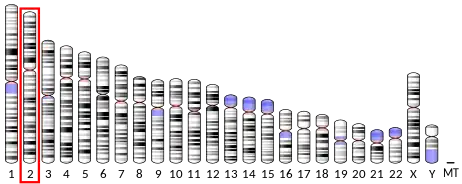PLCD4
1-Phosphatidylinositol-4,5-bisphosphate phosphodiesterase delta-4 is an enzyme that in humans is encoded by the PLCD4 gene.[5][6][7]
| PLCD4 | |||||||||||||||||||||||||||||||||||||||||||||||||||
|---|---|---|---|---|---|---|---|---|---|---|---|---|---|---|---|---|---|---|---|---|---|---|---|---|---|---|---|---|---|---|---|---|---|---|---|---|---|---|---|---|---|---|---|---|---|---|---|---|---|---|---|
| Identifiers | |||||||||||||||||||||||||||||||||||||||||||||||||||
| Aliases | PLCD4, phospholipase C delta 4 | ||||||||||||||||||||||||||||||||||||||||||||||||||
| External IDs | OMIM: 605939 MGI: 107469 HomoloGene: 88782 GeneCards: PLCD4 | ||||||||||||||||||||||||||||||||||||||||||||||||||
| |||||||||||||||||||||||||||||||||||||||||||||||||||
| |||||||||||||||||||||||||||||||||||||||||||||||||||
| |||||||||||||||||||||||||||||||||||||||||||||||||||
| |||||||||||||||||||||||||||||||||||||||||||||||||||
| |||||||||||||||||||||||||||||||||||||||||||||||||||
| Wikidata | |||||||||||||||||||||||||||||||||||||||||||||||||||
| |||||||||||||||||||||||||||||||||||||||||||||||||||
References
- GRCh38: Ensembl release 89: ENSG00000115556 - Ensembl, May 2017
- GRCm38: Ensembl release 89: ENSMUSG00000026173 - Ensembl, May 2017
- "Human PubMed Reference:". National Center for Biotechnology Information, U.S. National Library of Medicine.
- "Mouse PubMed Reference:". National Center for Biotechnology Information, U.S. National Library of Medicine.
- Kim H, Suh PG, Ryu SH, Park SH (Apr 2000). "Assignment of the human PLC delta4 gene (PLCD4) to human chromosome band 2q35 by fluorescence in situ hybridization". Cytogenet Cell Genet. 87 (3–4): 254–5. doi:10.1159/000015437. PMID 10702683. S2CID 40877378.
- Ghosh S, Pawelczyk T, Lowenstein JM (Jun 1997). "Phospholipase C isoforms delta 1 and delta 3 from human fibroblasts. High-yield expression in Escherichia coli, simple purification, and properties". Protein Expr Purif. 9 (2): 262–78. doi:10.1006/prep.1996.0682. PMID 9056492.
- "Entrez Gene: PLCD4 phospholipase C, delta 4".
Further reading
- Cefai D, Debre P, Kaczorek M, et al. (1991). "Human immunodeficiency virus-1 glycoproteins gp120 and gp160 specifically inhibit the CD3/T cell-antigen receptor phosphoinositide transduction pathway". J. Clin. Invest. 86 (6): 2117–24. doi:10.1172/JCI114950. PMC 329852. PMID 1979339.
- Zauli G, Previati M, Caramelli E, et al. (1995). "Exogenous human immunodeficiency virus type-1 Tat protein selectively stimulates a phosphatidylinositol-specific phospholipase C nuclear pathway in the Jurkat T cell line". Eur. J. Immunol. 25 (9): 2695–700. doi:10.1002/eji.1830250944. PMID 7589147. S2CID 20562627.
- Maruyama K, Sugano S (1994). "Oligo-capping: a simple method to replace the cap structure of eukaryotic mRNAs with oligoribonucleotides". Gene. 138 (1–2): 171–4. doi:10.1016/0378-1119(94)90802-8. PMID 8125298.
- Chen P, Mayne M, Power C, Nath A (1997). "The Tat protein of HIV-1 induces tumor necrosis factor-alpha production. Implications for HIV-1-associated neurological diseases". J. Biol. Chem. 272 (36): 22385–8. doi:10.1074/jbc.272.36.22385. PMID 9278385.
- Suzuki Y, Yoshitomo-Nakagawa K, Maruyama K, et al. (1997). "Construction and characterization of a full length-enriched and a 5'-end-enriched cDNA library". Gene. 200 (1–2): 149–56. doi:10.1016/S0378-1119(97)00411-3. PMID 9373149.
- Mayne M, Bratanich AC, Chen P, et al. (1998). "HIV-1 tat molecular diversity and induction of TNF-alpha: implications for HIV-induced neurological disease". Neuroimmunomodulation. 5 (3–4): 184–92. doi:10.1159/000026336. PMID 9730685. S2CID 19529677.
- Haughey NJ, Holden CP, Nath A, Geiger JD (1999). "Involvement of inositol 1,4,5-trisphosphate-regulated stores of intracellular calcium in calcium dysregulation and neuron cell death caused by HIV-1 protein tat". J. Neurochem. 73 (4): 1363–74. doi:10.1046/j.1471-4159.1999.0731363.x. PMID 10501179. S2CID 25410140.
- Mayne M, Holden CP, Nath A, Geiger JD (2000). "Release of calcium from inositol 1,4,5-trisphosphate receptor-regulated stores by HIV-1 Tat regulates TNF-alpha production in human macrophages". J. Immunol. 164 (12): 6538–42. doi:10.4049/jimmunol.164.12.6538. PMID 10843712.
- Ananthanarayanan B, Das S, Rhee SG, et al. (2002). "Membrane targeting of C2 domains of phospholipase C-delta isoforms". J. Biol. Chem. 277 (5): 3568–75. doi:10.1074/jbc.M109705200. PMID 11706040.
- Strausberg RL, Feingold EA, Grouse LH, et al. (2003). "Generation and initial analysis of more than 15,000 full-length human and mouse cDNA sequences". Proc. Natl. Acad. Sci. U.S.A. 99 (26): 16899–903. Bibcode:2002PNAS...9916899M. doi:10.1073/pnas.242603899. PMC 139241. PMID 12477932.
- Bennasser Y, Badou A, Tkaczuk J, Bahraoui E (2003). "Signaling pathways triggered by HIV-1 Tat in human monocytes to induce TNF-alpha". Virology. 303 (1): 174–80. doi:10.1006/viro.2002.1676. PMID 12482669.
- Ota T, Suzuki Y, Nishikawa T, et al. (2004). "Complete sequencing and characterization of 21,243 full-length human cDNAs". Nat. Genet. 36 (1): 40–5. doi:10.1038/ng1285. PMID 14702039.
- Lee SB, Várnai P, Balla A, et al. (2004). "The pleckstrin homology domain of phosphoinositide-specific phospholipase Cdelta4 is not a critical determinant of the membrane localization of the enzyme". J. Biol. Chem. 279 (23): 24362–71. doi:10.1074/jbc.M312772200. PMID 15037625.
- Leung DW, Tompkins C, Brewer J, et al. (2004). "Phospholipase C δ-4 overexpression upregulates ErbB1/2 expression, Erk signaling pathway, and proliferation in MCF-7 cells". Mol. Cancer. 3: 15. doi:10.1186/1476-4598-3-15. PMC 420486. PMID 15140260.
- Rual JF, Venkatesan K, Hao T, et al. (2005). "Towards a proteome-scale map of the human protein-protein interaction network". Nature. 437 (7062): 1173–8. Bibcode:2005Natur.437.1173R. doi:10.1038/nature04209. PMID 16189514. S2CID 4427026.
- Chae SW, Kim JM, Yun YP, et al. (2007). "Identification and analysis of the promoter region of the human PLC-delta4 gene". Mol. Biol. Rep. 34 (2): 69–77. doi:10.1007/s11033-006-9014-x. PMID 17394098. S2CID 24577383.
This article is issued from Wikipedia. The text is licensed under Creative Commons - Attribution - Sharealike. Additional terms may apply for the media files.




